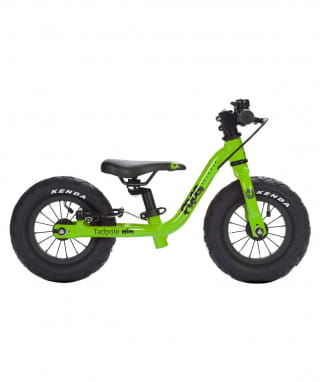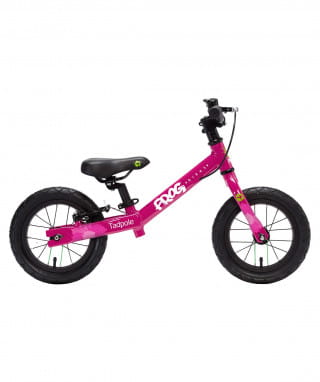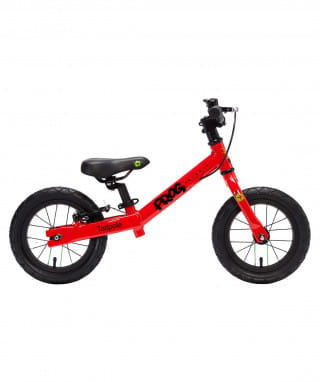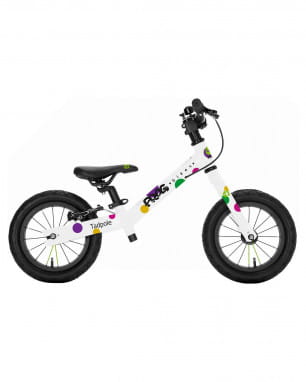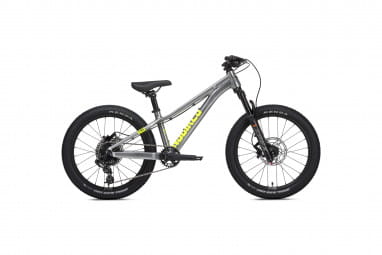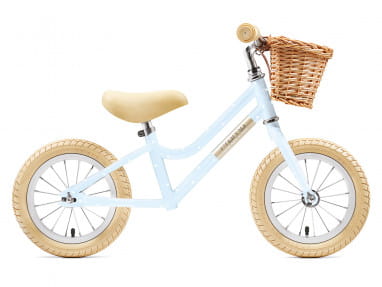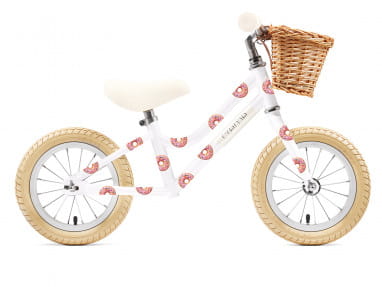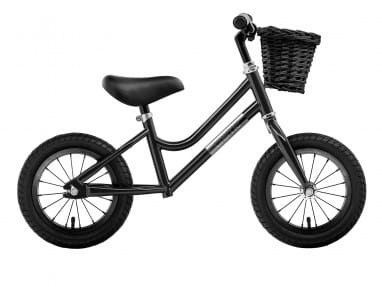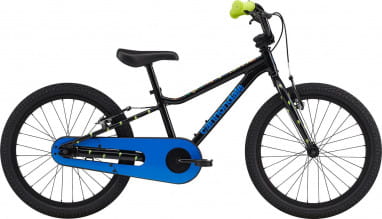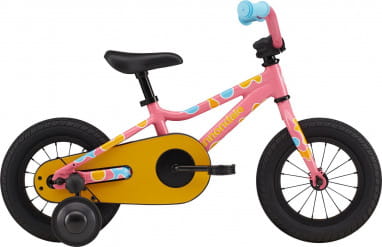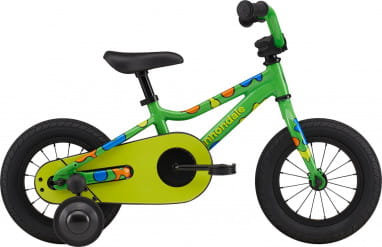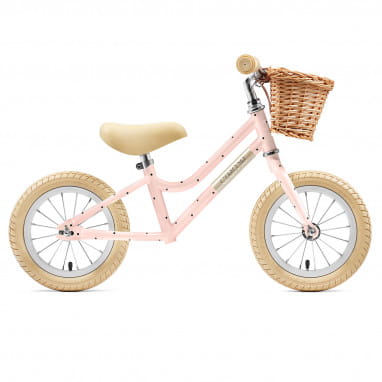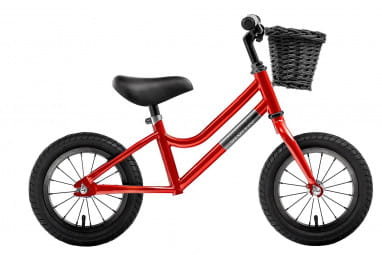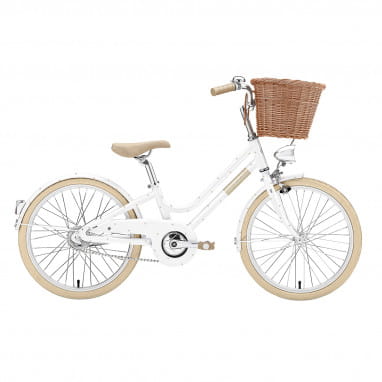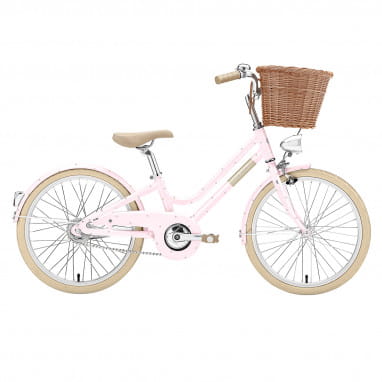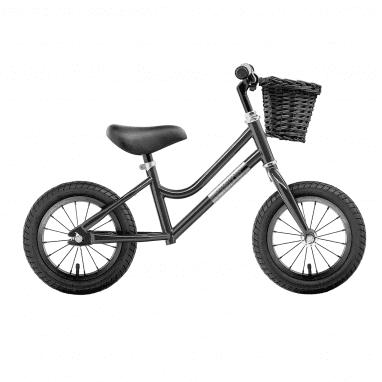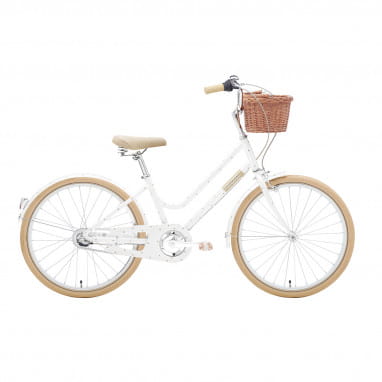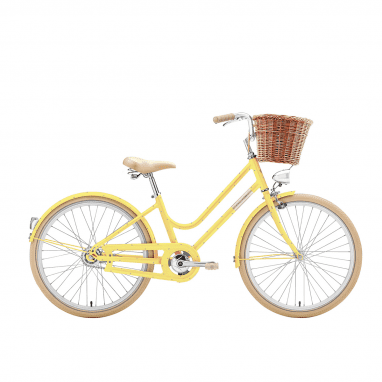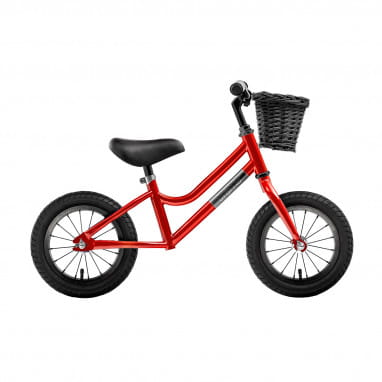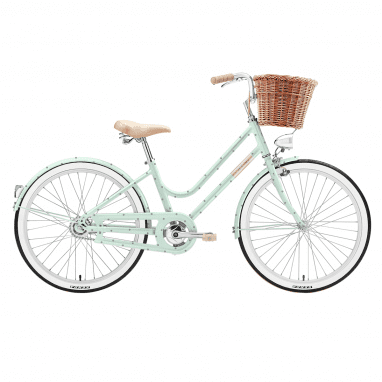There is a huge selection of children's bikes. Many brands, many colors, many bike sizes and the most diverse equipment variants, there is a suitable two-wheeler for every child to buy. You just have to find it first...
Buying a kids bike is actually not that hard. The smaller a child is, the less important the appearance of their bike probably is to them. The main thing is that it rides. The fewer components on it, the less likely it is to break. It is practical if the first bicycle or the wheel is as light as possible, everything else becomes a secondary matter. It becomes more difficult to choose a bike with a teenager. There must be a very specific color shade or it must be the same brand that all have in the class. For parents, a completely different criterion usually comes first: a favorable price.
When you browse our kids and youth bikes, you will find that we have a wide variety of models in our online shop. With the help of our buying guide, you're sure to find the right bike here.
The quick way to the answer:
For a toddler, you can just buy a running bike or a 12-inch or 14-inch bike. It will most likely just take it to its heart, no matter what it looks like or what manufacturer is on it. If you're with a bigger kid looking for a bike, experience has shown that buying online is particularly stress-free. Instead of throwing tantrums at the store, you can just pre-select here. Park a few children's bikes that come into question on our notepad. Then son or daughter can choose from those bikes, and it's a done deal.
How to find a kid's bike in the right size
For a child to control a bike well, the bike must be the right size.
-
Generally, most children ride more confidently on a slightly smaller bike, while they will lurch, wobble around, and also have difficulty getting on and off a bike that is too big.
- The most important consideration in bike fit is seat height, which is the height of the saddle. Younger children feel safer if they can extend both feet to the ground while sitting in the saddle. Later on, say from a 24 inch bike, it's enough if your child can still put one foot completely on the ground while sitting in the saddle.
- When pedaling, the little legs should not be fully extended in the lowest position.
- The frame must be shaped so that the child can stand comfortably in front of the saddle without touching the top tube.
- A child is best seated upright on the bike, as this allows them to see more and get a better sense of what is happening all around. A sporty, elongated seating position is only recommended for teenagers.
- The saddle and the handlebars of a children's bike are usually generously height adjustable. So you can adjust the bike to the individual proportions of your child and also readjust again and again. Thanks to the adjustable parts fit children's bikes with a little luck longer than just one season and you can skip one or the other bike size completely. This then saves a lot of money!
Can I buy a kids bike based on age?
Every child is different, some grow faster, others a little slower.
Buying a suitable children's bike just based on an age specification is really difficult.A bike has to fit the height, not the age. The legs have to reach the pedals, the hands should be able to grip the handlebars comfortably, so an age statement like "for 5-year-olds" or for "8-year-olds" is not very informative. Therefore, it is definitely recommended to determine the body size and measure the inside leg length before you start buying a children's bike.
Many children's bikes have an age rating, you can simply consider this as an indication of the equipment. For toddlers who can already walk, there are running bikes. Bikes for younger children, up to about elementary school age, usually have a hand brake and a coaster brake and no gears. 6- to 10-year-olds can handle simple hub gears. By the end of the elementary school years, at about age 10 to 12, children can learn to handle two hand brakes and a more complex gear shift.
But these are only guidelines! Maybe your offspring can handle gears earlier, maybe she or he wants to ride a fixie for life. The important thing is that the kids feel comfortable on the bike and can operate it as if in their sleep, only then they are safe on the road!
Buy a kids bike by body size
It's definitely safer to go by son or daughter's height when buying a bike. The inside leg length or inseam length also helps in making a choice. To help you measure them and then find the right frame size to go with them, we've got a
guide for this on our blog for you.
While adult bikes are measured by frame size, children's bikes are measured by the diameter of the wheels. It is specified in inches. Therefore, one speaks for example of a 20-inch bicycle, or reads of a 12"-bicycle, it has then a wheel diameter of 20 inches, or 12 inches.
Which children's bike size is suitable for which age?
- From about 86 cm in height, from about 30 cm stride length - running wheels
Even under three years children can make the first attempts on the running wheel. Once your little one can walk safely and freely, a small running wheel or a slide car is crazy fun for the munchkins! If the vehicle is to remain indoors, you can buy a model with whisper wheels, so the rolling noise is kept within limits. Since the responsiveness is not yet very pronounced, the first driving attempts should take place far away from any car traffic!
>Explore our wheels from Early Rider, Kokua or Creme Cycles.
- From 95 cm tall, from 40 cm stride length / 12 inches
From about 3 years, most children start their first experiences on a 12 inch children's bike. These bikes should bring as little weight as possible and also otherwise the equipment may keep within limits. Mostly the children are completely occupied with it to hold their balance and steer. A gear shift would overtax them. Many of these bikes have a coaster brake and a hand brake, but there are also models with two hand brakes. There are bikes with training wheels here, but if a child can already ride a running bike, these are often unnecessary.
There are also larger wheels with 12-inch tires.
>Here's where to find our 12-inch kids' bikes from Cannondale.
- From 100 cm tall, from 45 cm stride length / 14 inches
14 inch children's bikes tend to be less common, as children often go straight from 12 inch to 16 inch. Nevertheless, 14 inch kids bikes are suitable from about 3 to 4 years old.
>Early Rider supplies cool 14 inch kids bikes.
- From 105 cm tall, from 48 cm stride length / 16 inches
From a height of about 105 cm or about 4 years, your child can sit on a 16-inch children's bike. With these bikes, there are already many models with two hand brakes, in addition, training wheels are still available in this size. You can also buy the first models with disc brakes in 16 inches, you can read more about suitable braking systems below.
>You can buy 16-inch bikes from Trek, Orbea or Cannondale here.
- From 115 cm tall, from 51 cm stride length / 18 inches
From about 5 years, a bicycle with 18 inch wheels is usually suitable. This bike size is also often skipped right over.
- From 120 cm tall, from 55 cm stride length / 20 inches
In the 20 "children's bikes there is already a very large selection of various manufacturers and many different equipment options. In this size, there are "real" mountain bikes with suspension fork, some even bring a frame damping. Even real freeride bikes for use in the bike park are offered in 20 inches. But you can also buy a comfortable everyday bike with mudguards and a rack. From 20 inches upwards, most bikes have gears; there are uncomplicated hub gears, but derailleurs are also used. Children from about 6 years of age or from primary school age can handle 20 inch bikes just fine.
>Find kids' bikes in 20 inches from Liv, Giant or Pyro Cycles.
- From 135 cm tall, from 65 cm stride length / 24 inches
These bikes are suitable for children from about 9 to 11 years. From this size, the bikes become more and more similar to adult bicycles. They come in very different orientations, some are sporty mountain bikes, others extremely practical city bikes with complete comfort equipment. The first e-bikes can also be found here. There are also road bikes from 24 inches, but these are only recommended if your child pursues road cycling as a sport and does not want to ride on public roads. The stretched posture severely restricts vision and is not suitable for everyday use! With this bike, most children will take their cycling test at school, so parents should look for a bike with StVZO equipment.
>24 inch kids bikes can be found on BMO from Trek or Creme Cycles among others.
- From 145 cm tall, from 70 cm stride length / 26 inches
From a height of about 140 cm, children can switch to a 26" youth bike. Usually this bike size fits from the end of elementary school. Here there is actually no difference to "normal" bikes, because many smaller adult bikes also roll on a wheel size of 26 inches. The selection here is correspondingly large, there are all colors, all frame shapes and all components that can be found on the bike market.
>26 inch youth bike is available from Liv, Giant or Orbea.
All bike sizes at a glance again:
|
step length
|
body size
|
age
|
Bike size
|
|
approx. 30 cm
|
ca. 86 cm
|
up to 3 years
|
Wheel
|
|
from 40 cm
|
from 95 cm
|
approximately 3 years
|
12 inches
|
|
from 45 cm
|
from 100 cm
|
about 3 to 4 years
|
14 inches
|
|
from 48 cm
|
from 105 cm
|
ca 4 years
|
16 inches
|
|
from 51 cm
|
from 115 cm
|
about 5 years
|
18 inches
|
|
from 55 cm
|
from 120 cm
|
ca 6 years
|
20 inches
|
|
from 65 cm
|
from 135 cm
|
approximately 11 years
|
24 inches
|
|
from 70 cm
|
145 cm
|
approximately 12 years
|
26 inches
|
As mentioned above, these are guidelines and recommendations, some variation is possible. Nevertheless, they give you clues for the right size of the children's bike.
Which children's bikes are there?
As the size increases, children's bikes also become more specialized. The more specialized a bike becomes, however, the more its range of use narrows in turn. For most children, a comfortable all-round bike is best suited, a mountain bike or road bike then makes sense for teenagers.
City bikes or all-round bikes for children
Small children's bikes are usually versatile and therefore practical and comfortable all-rounders, reminiscent of city bikes for adults. The all-round models are suitable for city tours as well as for the way to the playground, the way to school or for trips with the family. They are usually equipped with all the necessary attachments required by the StVZO and can thus also be used for the bike test without any problems. In the smaller sizes (12-20 inches), the StVZO equipment is usually not yet installed, since the children are still obliged to ride on the sidewalk anyway due to their age and thus do not participate directly in road traffic.
ATB - All Terrain Bikes
The ATB is similar in design to the all-terrain bike, but usually has slightly coarser tires for light off-road use. Attachments such as a luggage rack are also often omitted here. Overall, it comes across a bit sportier than a city bike and also has a higher set top tube.
Mountain bikes from 16 inches to 24 inches
Kids' mountain bikes are designed to be ridden off-road. From as little as 16 inches, you can buy kids bikes that look like MTBs, but still have kid-friendly features. Studded tyres are often combined with a suspension fork and powerful V-brakes or disc brakes. StVZO equipment is always dispensed with here. These bikes are also only conditionally suitable for longer tours, they may not participate in road traffic without lighting and reflectors. From 20 inches are very rare Fullys to find, from 24 inches there are isolated Fullys and a variety of Hardtails.
BMX bikes
Even though BMX bikes are small, they are rarely meant for kids! BMX bikes are suitable for practicing new tricks in the skate park, for example. For road traffic and trips they are completely unsuitable.
Racing bikes for kids
Racing bikes are trimmed for top speeds, and it's no different with kids' racing bikes. The sporty component is the main focus, so these bikes only make sense for children if they want to actively pursue bicycle racing. They are absolutely unsuitable for road traffic, because the far forward leaning seating position means that children can't see much, and they are also more likely to be overlooked. Racing bikes for children are available from 24 inches.
Children's e-bikes
They exist, and they become more with each model year: e-bikes for children and teenagers. Starting at 24 inches, kids can be propelled by an e-drive. The motor power and the speed are here, however, still strongly throttled.
Why should a children's bike be as light as possible?
A high-quality children's bike is characterized first and foremost by being as light as possible. This aspect is really important, as children do not yet have much muscle strength and are quickly overwhelmed with heavy bikes. With a light children's bike, on the other hand, they can playfully handle, pick it up, carry it up stairs or ride uphill quite easily. Basically, the lighter a kids bike is, the easier it is for the child to handle it.
When you are on the road with a toddler, you enjoy an additional personal advantage if the vehicle weighs as little as possible. Every parent knows the situation: At first, the toddler wants to drive himself, but halfway through the journey he or she suddenly doesn't feel like it anymore. Then someone has to carry the bike or running bike, somehow it has to get home. A light bike is very easy on the back. If you then attach a carrying strap to the saddle and handlebars, you can hang it over your shoulder and you'll arrive home easily and without drama.
Which brake is suitable for a child's bike?
There is a hot debate among parents and bike manufacturers as to whether or not a coaster brake on a child's bike is a good idea.
Some imagine it easier to brake with either hands or feet. Others have concerns about whether kids can switch from pedaling to braking quickly enough in an emergency, and then also find a crank position fast enough to build up good braking power.
To avoid overtaxing the minis, wheels often have no brakes at all. Here, braking is done with the feet, which every child learns quickly and easily. Riding barefoot, however, is not a good idea!
Larger bicycles have a handbrake. So the children can get used to braking, but if necessary still take the feet to help.
Small children's bikes with 12 inch, 14 inch or 16 inch have either a hand brake and a coaster brake or two hand brakes. As a rule, uncomplicated rim brakes are installed here.
From 20 inches there are children's bikes with disc brakes. There is a choice of bicycles with two hand brakes or with one hand brake and one coaster brake.
Bikes with disc brakes are also available.
This is to be considered:
- The brake levers must be adjusted so that short children's fingers can reach them.
- The brake levers must also be easy to pull, because children have less strength in their hands.
- Even on smaller bikes, the brakes must not be too biting under any circumstances. Children find it difficult to dose the braking force. Involuntary emergency braking would send a child flying over the handlebars.
- If your child rides a bike with disc brakes, you should explain to him that the brake discs must not be touched, because they get very hot during use!
- Let your child first brake a few times while pushing the bike when trying a new bike for the first time. This will allow him or her to get used to the braking force. Especially with disc brakes, this is important, because they brake particularly well!
Which circuit is suitable for a children's bike?
There are usually no gears on 12" to 18-inch children's bikes. 20-inch bikes have simple hub gears. These gears have many advantages: kids can easily learn to shift with a twist grip, they can't get lost, the chain won't jump off, and the gears are tough and won't break if the bike falls over. Unless you're planning mountain tours, three to five gears is a good choice to start with. That way, kids can slowly get used to the right gear selection.
On larger children's bikes there is then optionally still a hub gear or extensive derailleurs. Here, the shifting process is much more sophisticated, but derailleurs are more expensive, more sensitive and more complex.
The choice of gears should firstly be based on the child's ability, and the terrain also plays a role. If you want to conquer slopes together with your child or ride off-road, a derailleur is much more comfortable. But you should not overtax your child. Only a child who rides very safely, brakes and can operate a hub gear, can also easily cope with a derailleur.
Pink and blue or green, black and red - bikes for girls and boys
.
Older kids like to ride a bike in their favorite color, so we have many different color options to choose from in the BMO online store. Whether you buy a typical girl's bike in pink with flowers, a green boy's bike or a gender neutral grey or black bike is of course a matter of taste. There is only one thing to remember here: If you invest in a good children's bike, it can easily be passed on. Whether the younger son will then enjoy riding his big sister's pink bike is questionable. At worst, you'll have to resort to spray paint.
The manufacturer Liv only builds bikes for women, and girls' bikes are available here from 24 inches upwards.
Should a child's bike have training wheels or not?
If children have ridden a running bike for some time before, the switch to a children's bike without training wheels is usually very easy for them, because they are already used to keeping their balance. They then only have to learn how to pedal. Often, all it takes is half an hour of practice and they have successfully become a bike rider.
If training wheels are fitted, you can adjust them so that they stand a few centimetres higher than the actual wheels of the bike. This will allow children to find their balance without risk, as they will be cushioned by the training wheels when in doubt.
Children's bicycles in road traffic - What criteria must be met according to the StVZO?
Finally, the right bike has been found and now it is to be used in public road traffic. For this, the children's bike must of course be StVZO approved . Important for this are:
- a well audible bell
- two independent brakes
- a white headlight in the front
- one white reflector in the front ( it may also be integrated in the headlight)
- four reflectors in the spokes (two each front and two rear)
- the power supply of the lights may now no longer be only via a dynamo, also bicycle lights with battery and accumulator are allowed
- Red rear light with reflector at the back
- Non-slip pedals with reflectors on front and back
- Spoke reflectors or reflective material on the rims, spokes or coats
Although kids sometimes aren't thrilled about it - a bike ridden in traffic should be more safe than cool!
Children are not allowed to actively participate in traffic until they have successfully completed their bike test. Before that, they must ride on sidewalks or in appropriate play streets and parks. Here, kids should always be accompanied by a supervisor.
What does a good children's bike cost?
Wheels generally cost between about 100 and 200 euros. Since there is not yet much technology on these toys, the prices are correspondingly cheap. Of course, there are also cheaper no-name products, they weigh then significantly more and are usually not particularly durable.
For small bikes up to 20 inches you should estimate 250 to 500 euros. The higher the price, the more durable the frame and components, and at the same time, as the price goes up, the weight goes down.
Most 24" children's bikes have similar prices, but here you can also spend significantly more if you want to buy a mini mountain bike or a road bike in small format.
From 26 inches cost children's bikes roughly 500 euros. The bikes then come from good manufacturers, they have solid components that accompany your child reliably in everyday life. Since you can shop here but also in the small adult bikes, there is actually no price limit upwards.
.
Which of our children's bikes are particularly good is difficult to say, because every manufacturer has different priorities. Generally, as the price goes up, so does the quality of the frame and components. Kids and youth bikes that cost a little more are more durable and lighter at the same time. But there is another advantage if you go for the products of well-known brands here. Children's bikes eventually become too small, a good bike then has a higher resale value.
.
What to look for when buying a children's bike?
.
- There is noideal timeor guideline for when to buy a kids bike. Most children start their career on two wheels at 1 to 2 years old on a running bike, when they can walk safely. Here, small running bikes are still best suited, on which the children always have their feet on the ground. These running wheels can usually also be tried out without any problems in their own four walls.
- If the purchase of a first real children's bike is pending, it offers this in the spring to make, because then the bike season is just around the corner and the children can start directly in their first adventures.
- Although kids may find a sporty bike with a diamond frame, i.e. a high-set top tube, much fancier, they usually do better with a low step-in.
- Many kids like to carry a few important odds and ends on the go. Then they need a luggage rack. If none is available, it can be retrofitted to bikes that have the necessary mounting mounts.
- Even with children's bikes, a chain guard is very practical, because it prevents the drive from being damaged if the bike falls over. In addition, trouser legs and skirt tails do not get into the bicycle chain.
- Children should never get on a bike without a suitable child size bike helmet!
- Even very young children will catch a fall with their little hands. mini bike gloves will then protect against abrasions.
- For your offspring kamikaze rider, there are also kids' protectors.
If you then approach your first driving attempts with a little patience, and practice with smaller children far away from car trafficr first, nothing can really go wrong!
<
Please note that all statements regarding legal requirements are made without warranty.
